Mesh screens for armored vehicles AmSafe Tarian (UK)
According to the results of the first battles in Iraq, by the mid-2000s, the British army became interested in promising means of additional protection for armored vehicles. Among other things, various hinged screens were studied that could prevent the defeat of their own body of a combat vehicle. In 2005, AmSafe Bridport was involved in work in this direction, having previously had no experience in the field of protective gear for people or military equipment.
However, the invitation of this company was quite reasonable and logical. The main field of activity of EmSafe is special textile materials. She designs and manufactures various cargo equipment for aviation, first of all, pallets with chains, safety cables, etc. In particular, a few years ago, it introduced a mesh system to the market that can hold objects in place during overloads of up to 9 units. The company's experience in creating particularly durable yarns and textiles could be used to protect armored vehicles.
In 2007, AmSafe Bridport, together with the Defense Science & Technology Laboratory (DSTL), developed a preliminary draft of a promising defense. It has been shown that the use of existing technologies makes it possible to create a rather successful hinged screen. The new protection, showing the required characteristics, was much lighter than traditional metal systems. In addition, an opportunity was found to simplify the installation of new screens.
Soon, the AmSafe project received its own name, under which it was proposed to promote it in the domestic and international markets. New protection system called Tarian. Subsequently, as new variants and configurations appeared, corresponding designations were proposed, such as Tarian Xtreme or Tarian QuickShield.
The Tariyen product is based on a special synthetic thread, developed by EmSafe in accordance with the requirements. From such a thread, differing in relatively large thickness, it is proposed to weave cables, which, in turn, should be connected into a net. According to the developer, the new material has a high mechanical strength and is able to withstand loads of various kinds. So, the cable is extremely difficult to cut by hand, and the bullets or fragments cause him minimal damage. Contact with certain objects does not lead to rapid abrasion of the fibers and the mesh as a whole. In addition, the cables from the new thread do not burn, which to a certain extent increases the effectiveness of protection against various threats.
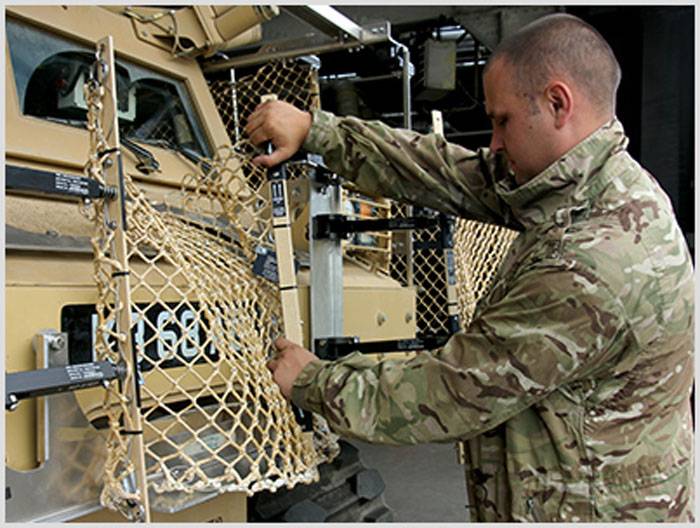
Network installation process on racks
In its simplest configuration, the Tarian RPG Armor mesh screen is a diamond-shaped mesh formed by multiple intertwined individual cables. The dimensions of the network cells are determined in accordance with the dimensions of the main threats. Once between the individual cables, anti-tank ammunition still will not be able to hit the armor. The manufacturer offers to hang the network on racks or frames of the required sizes and install them on combat vehicles like other types of screens. At the request of the customer, frames can be used, unified with the units of existing cutting screens.
The Tarian stretched network performs the functions of a vertical and cutting screen at the same time. Anti-tank ammunition with a cumulative warhead, getting into a network of strong cables, can be deformed from a strike, up to a complete loss of efficiency. In this case, the undermining of the warhead is excluded, and the protected machine does not receive damage. The network can also work like a hard anti-cumulative screen: a grenade or a rocket explodes at a certain distance from the armor, as a result of which the efficiency of a cumulative jet drastically decreases.
A relatively soft and resilient net, stretched over the frame, can also protect the combat vehicle from incendiary bottles, hand grenades and other similar threats. The flying object will be dropped from the car. If a flammable liquid gets onto the network, the latter will remain operational and continue to protect the equipment.
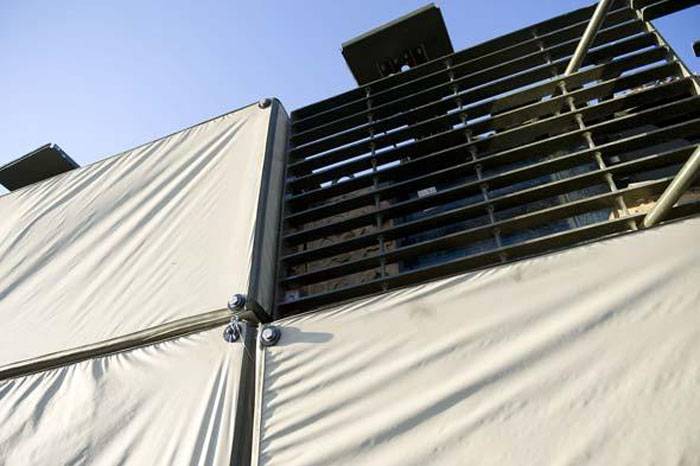
Mesh, covered with fabric screens. If necessary, the latter may have a camouflage color.
The project "Tariyen" provides for the possibility of using another means of additional protection that increases the survivability of the machine by reducing visibility. A textile cloth with camouflage coloring can be hung over the screens on the frame. With it, you can quickly and easily bring the combat vehicle into line with the existing landscape. What is important, tissue masking does not affect the mesh screen, and also does not require any modifications of the basic technique.
The main advantage of the Tarian system, according to its developers, is its low weight and compactness. According to official data, the screen of the grid from "EmSafe" has a specific weight of not more than 5,7 kg per square meter. Thus, it is approximately twice as light as an aluminum grid with similar protection parameters. Steel module additional booking, showing the same characteristics, will be seven times harder. Thus, the products of the Tarian family minimally burden the combat vehicle and almost do not spend its stock of carrying capacity.
Lightweight screens, which are easy to install, also facilitate the operation of equipment. In the dismantled and folded form, the grid takes up minimal space, which simplifies the transfer of armored vehicles by rail or military transport aviation. Replacing screens does not take much time.
Shortly after the appearance of the preliminary project, AmSafe Bridport together with the DSTL organization produced an experimental batch of promising screens and conducted the first tests. During the checks, the nets were subjected to various influences, including open fire and shelling from infantry weapons, aimed at studying the operational characteristics and overall strength. In addition, the screens were checked in the original role - as a means of protection against cumulative anti-tank ammunition. It was found that the system Tarian RPG Armor copes with its tasks and is really able to protect the combat vehicle from a number of existing threats.
For several months, mesh screens were checked at the test site using stands. In 2009, several armored vehicles used by the British Army became platforms for new tests. Protection specifications have been confirmed. By this time, the first references to the plans of the armed forces in the context of future purchases and the use of new products.
It was mentioned that the carriers of new screens can be any combat armored vehicles and auxiliary equipment available in the troops. So, the Tarian system could replace the existing lattice screens installed on the MCV-80 Warrior infantry fighting vehicles. It was also of interest in the context of refitting lightweight BvS-10 Viking all-terrain vehicles. The latter have a limited capacity, much of which is spent on heavy metal screens. Finally, a proposal was made to use grids on stationary objects. Roadblocks or other facilities in hot spots are subject to known risks, and the screens of the simplest design could be used to increase their survivability.
In the spring of 2009, after conducting a series of inspections, the British Army ordered the production of an installation batch of Tariyen screens. Networks were suggested to be mounted on frames designed for Oshkosh HET trucks. The first order involved the production of 20 complete kits for such a technique.
In June of the same year, AmSafe Bridport showed its development for the first time at a public event. Soon, it was alleged, the military of several foreign countries became interested in additional protection based on networks. In the foreseeable future, new supply contracts were expected to be signed, including with foreign armies.
Further development of existing technologies has led to the emergence of new products. As part of the Tarian Xtreme project, a new cable was created with the required characteristics, as well as new frames for installing the grid. Due to this, it was possible to further reduce the weight of the complete system. The Xtreme network is four times lighter than the aluminum grille and 10 times lighter than steel. In this case, all compared screens show the same protection characteristics.
In 2011, the new Tarian QuickShield screen went into series. The basis of this project was the idea of saving and combining different products. The QuickShield system includes a synthetic network of 100x44 size or cm 170x100 cm, a set of mounts and tools for installation. According to the creators, in the event of damage to the existing metal grille, the crew of the combat vehicle must remove the "waste" section, and in its place tighten the grid. This approach allows you to carry out the necessary repairs in the field and keep the required level of protection in the most simple way.
In March, 2011, the British military and AmSafe entered into an agreement that required several hundred sets of Tarian QuickShield worth a total of 2,6 million pounds. Apparently, the serial products of the new type were planned to be used in the framework of operating equipment with rigid screens of existing models.
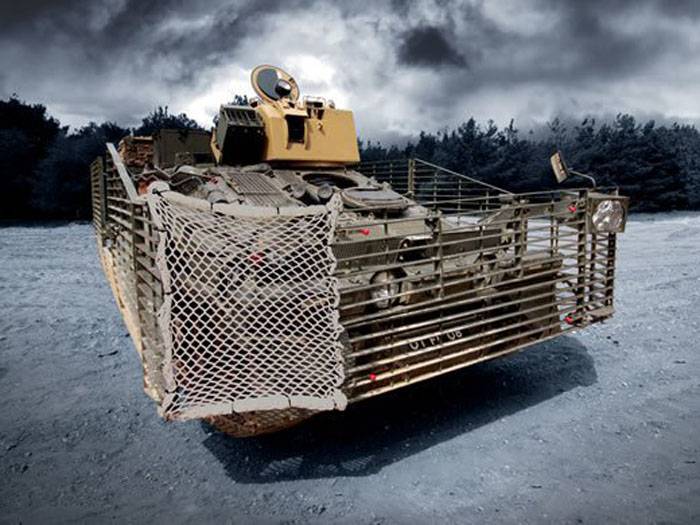
BMV MCV-80 with different screens. The zygomatic grate is removed, the opening is closed by the Tarian QuickShield system
In the autumn of the same year, the British company AmSafe Bridport agreed to cooperate with the American Textron. Two organizations planned together to continue the development of the project and to offer mesh screens of the American army. The joint development system was to participate in one of the future Pentagon contests.
According to known data, to date, the UK has managed to order and receive at least several hundred AmSafe Tarian mesh screens of a number of modifications. The most widespread representative of this family so far is the QuickShield system, designed for field repair of hard means of additional protection. This is primarily due to the fact that such devices are already in service and used by the troops. Technique of new construction, perhaps, will initially carry the screens "Tariyen."
According to the information of the company-developer, the screens of the Tarian line show quite high combat characteristics, but at the same time they are distinguished by ease of operation and low weight. The presence of several contracts for the serial production of such products serves as a kind of confirmation of these data. Grids of synthetic rope, woven from a special fiber, can really show the possibilities at the level of metal cutting grids.
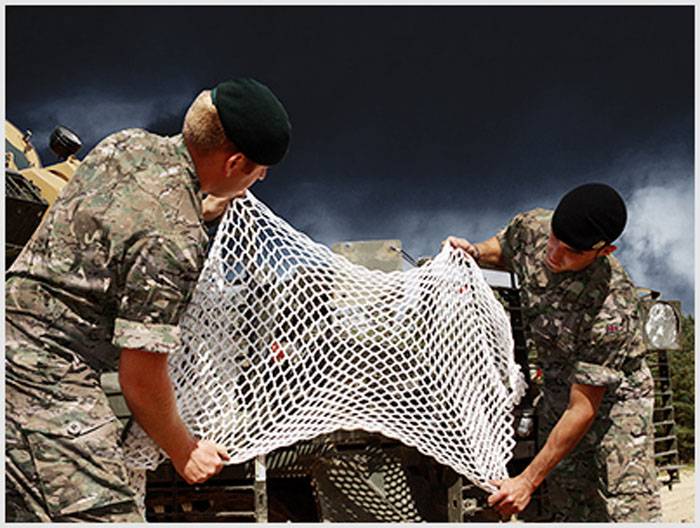
Fighters tighten the QuickShield net
However, it should be recognized that the additional mesh screen retains all the major flaws of its tough predecessors. It is not a universal defense against all threats and, for example, cannot protect an armored vehicle from a rocket with a tandem warhead. It is also useless when hit anti-tank ammunition, hitting the target due to its kinetic energy. In addition, the undermining of the shaped charge is guaranteed to tear and disable almost the entire section of the grid and leave a certain sector without protection.
However, it should be borne in mind that the goal of the Tarian project was not to create additional protection for armored vehicles capable of withstanding any threats, including the most difficult ones. Mesh screens were supposed to be an alternative to existing gratings, characterized by a smaller mass and greater ease of operation. This task was successfully accomplished, and the British ground forces received the desired devices. Now they are used with other mounted additional protection tools.
Additional protection for a combat armored vehicle can be carried out using various types of mounted modules. One of the options for such equipment - a network of wire or synthetic yarn. As the example of the AmSafe Tarian project shows, such protection is capable of solving the tasks assigned to it and protecting various types of equipment, and is also characterized by greater simplicity, convenience and flexibility of application.
On the materials of the sites:
https://amsafebridport.com/
https://defenseindustrydaily.com/
http://defense-update.com/
http://janes.com/
http://army-guide.com/
- Ryabov Kirill
- AmSafe Bridport / amsafebridport.com, defense-update.com
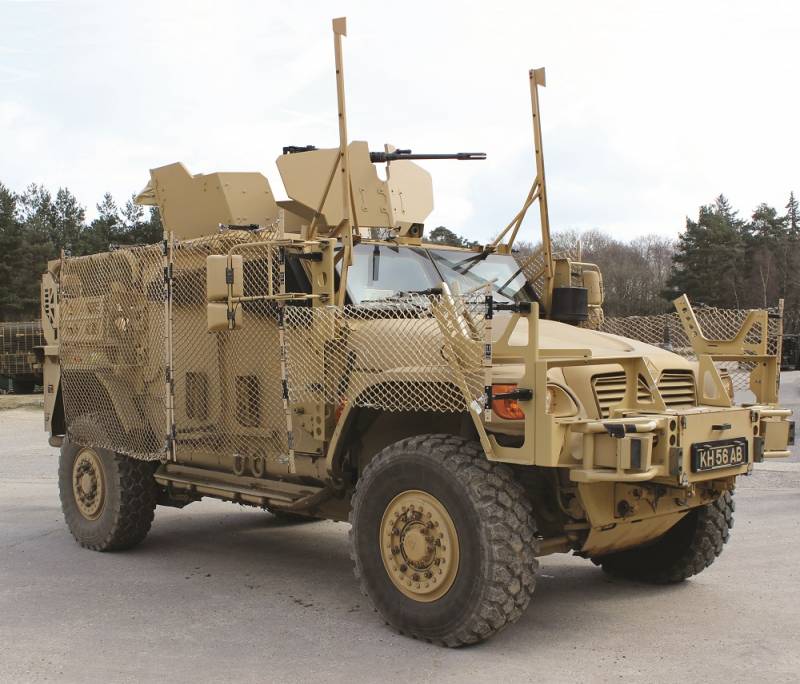
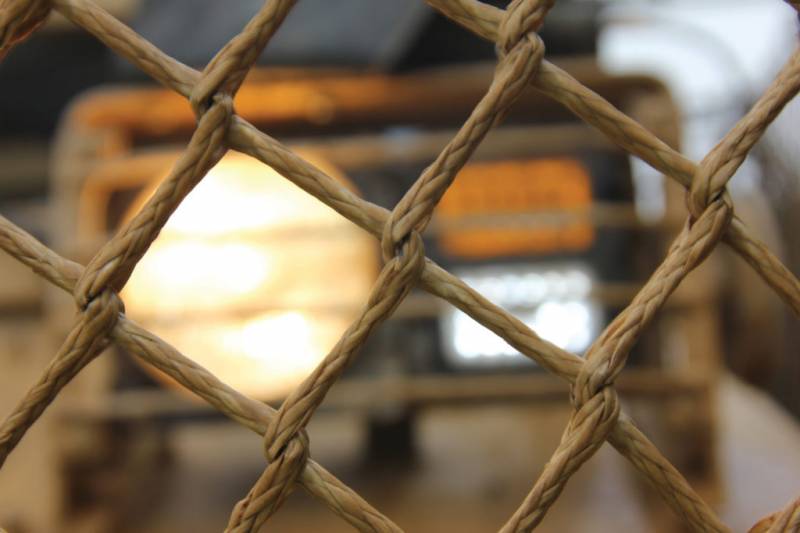
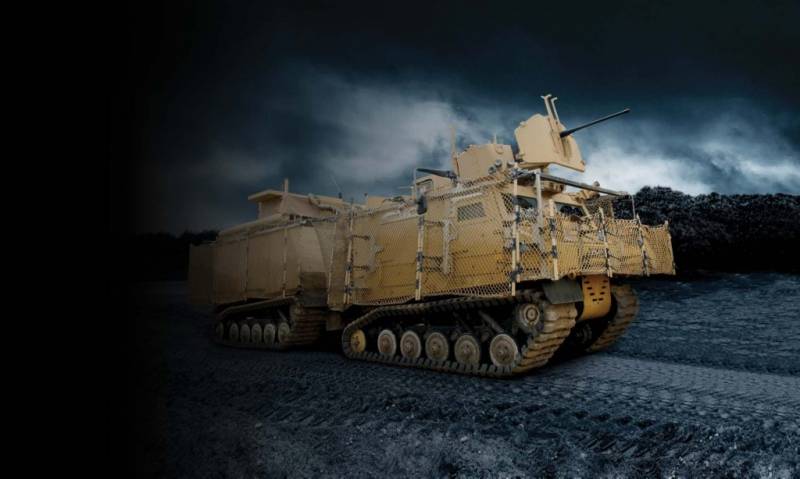
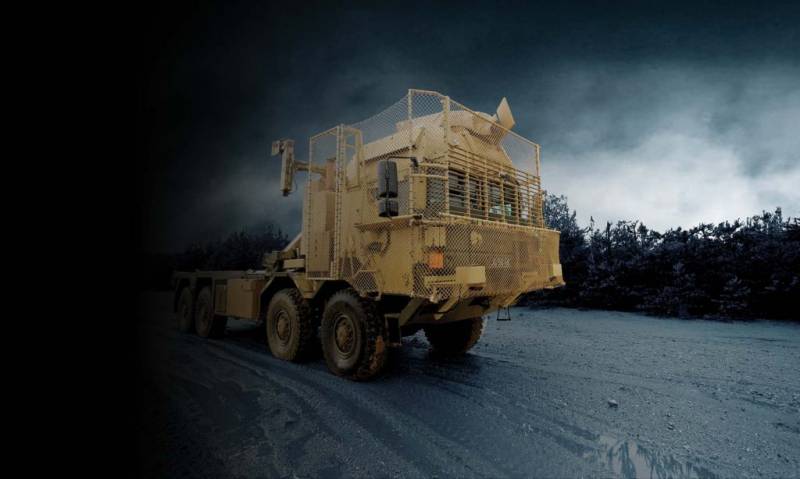
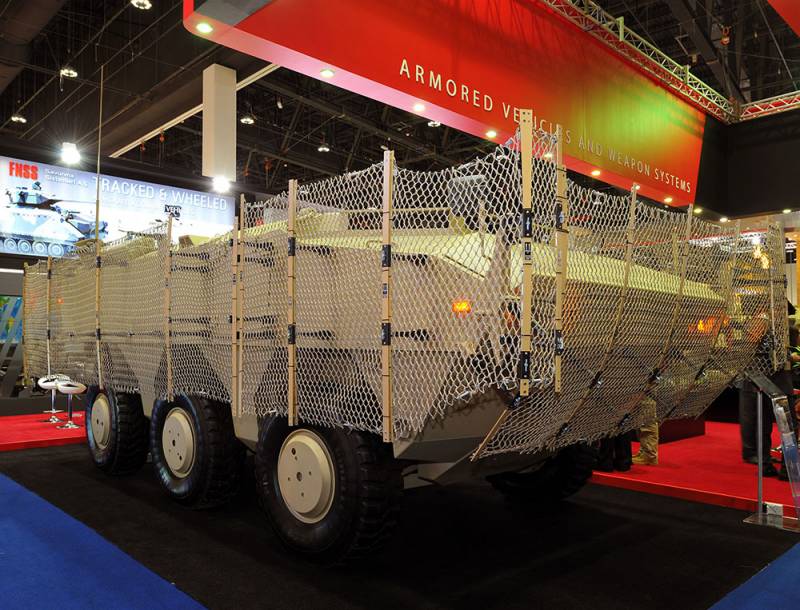
Information